Posts Tagged ‘Wet Soils’
11
Dec
Posted by steven1111 in Berries, Conifers, Dwarf Plants, Garden Construction, Gardens, Grasses, Nature, Peat Bogs, Pruning, Sanctuaries, Shrubs, Snow, Trees, Unusual Plants, Vegetables, Wet Soils. Tagged: Conifers, Dwarf Plants, Gardens, Nature, Peat Bogs, Personal Gardens, Pruning, Sanctuary, Unusual Plants, Vegetables, Wet Soils. 2 comments
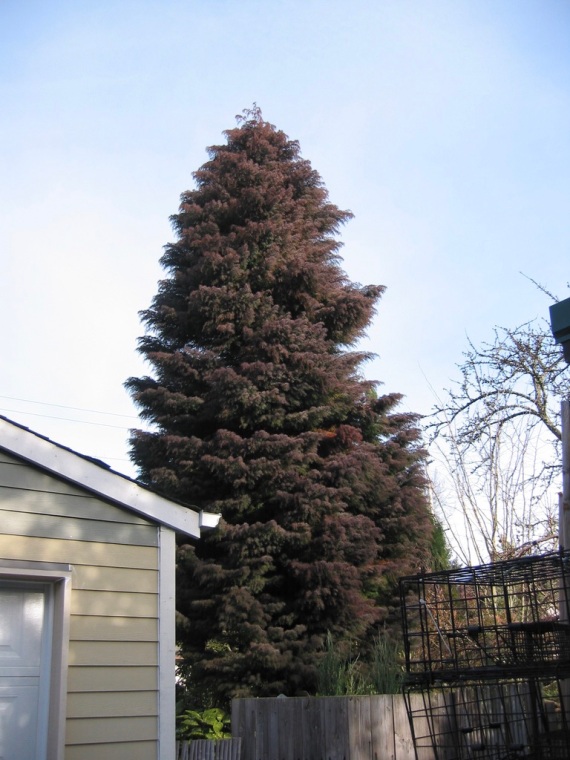
This is the Elegans. It’s formally called Cryptomeria japonica “Elegans”, or Elegans Sugi in Japanese. This is a photo I took from our neighbor’s yard because you can’t see this full a picture from our yard. Too many trees in the way. I planted it about 10 years ago from an 18″ sapling. I’d say it’s closing in on 30′ now. Wow. It’s one of my favorite “pettable” trees because you can literally pet it it’s so soft and luxurious. Not like other conifers at all – the ones that stick you so readily.
The photos in the following series form a panoramic view of the back garden from the base of the Elegans, on the other side of this photo. From there you can pretty much see the whole back garden. It’s a comfortable, dry spot to stand at times when there’s a little bit of drizzle like we have coming down today. I’ll show you in the next photo.
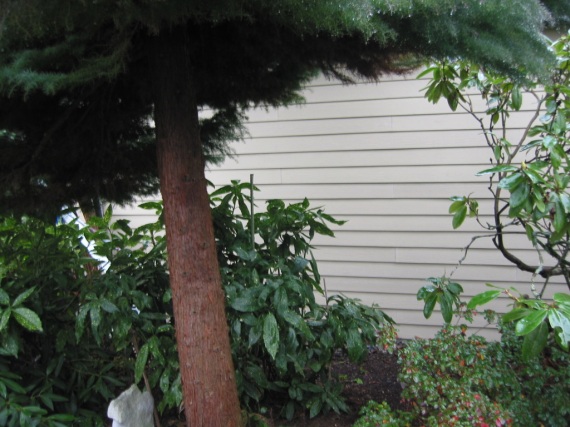
This is where I’m standing. The trunk is angled in such a perfect way that I can lean back against it and it supports my back like a recliner. Nice for a bad back – the gardener’s curse. Underneath the Elegans is what’s left of the formerly large Gold Dust plant (Aucuba japonica) that I almost killed by planting the Eleagns were I did. Silly me. I was able to prune the Aucuba so that it now grows luxuriously on the margin of the Elegans. It gets lots of sun and can grow tall again.
On the right is a Blue Peter rhododendron that Louie planted here some 30 years ago. In the spring it’s a mass of light purple flowers with darker purple centers. A lovely older variety. Below is the most wonderful azalea in the garden, in my opinion. It’s a Kurume called “Ward’s Ruby” (Azalea kurume “Ward’s Ruby”). When it blooms it’s covered with the deepest red blossoms imaginable and can be seen from the house. It loves it here. In fact all the Ericaceae (Heather family) thrive in the deep, wet, peaty soil we have here in our little Nature Sanctuary. You’ll see a variety of acid loving plants here.
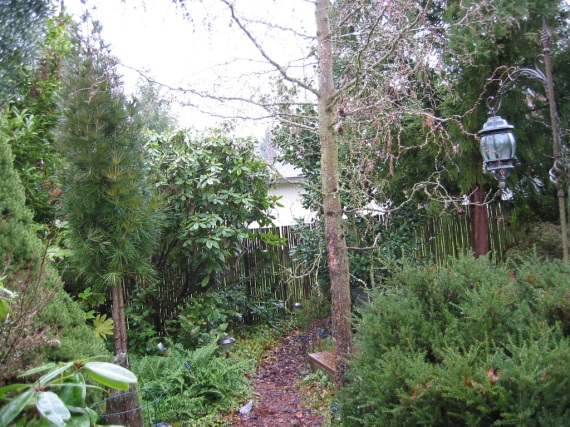
This is what I see when I look to my left. The tall spindly tree on the left is a “bound” Japanese Umbrella Pine form called “Wintergreen” (Sciadopytis verticillata “Wintergreen”). It’s bound because it was damaged in the “snopocalypse” we had in February (we don’t get much snow here so we tend to be dramatic about it when we do get it….). I had to tie up all the branches because they were drooping so badly from the weight of the snow. I’ll keep the ties on for a year or so and then remove them. The branches will (hopefully) bounce back up to where they’re supposed to be. Below it is a huge patch of Licorice fern (Polypodium glycyrrhiza). It’s a PNW native you often see on the trunks of trees in the rainforest.
Next to is is a stalwart rhodie called Anna Rose Whitney. It’s about 6′ x 7′ now and when it blooms in spring it’s a mass of brilliant hot pink with huge trusses of 8 or 10 flowers each. Very impressive. The tall tree with the twisty branches to the right is a “Diana” contorted Japanese larch (Larix kaempferi “Diana”). It’s one of the handful of deciduous conifers in the world. It has apple green needles all summer that turn a marvelous shade of deep orange before dropping in the fall.
At the bottom right is a rarely seen Alpine Yew Pine (Podocarpus alpinus “Red Tips”). It’s from New Zealand and is related to the better known Japanese Yew Pine (Podocarpus macrophylla). It has beautiful reddish purple tips in late spring. It looks like a haze over the whole plant. Above it is the trunk of the Radicans Sugi. That’s the big dark green tree in back, behind the lamp. It covers an edge of the little deck we built so we could hang out in the garden. More on the Sugi in a moment.
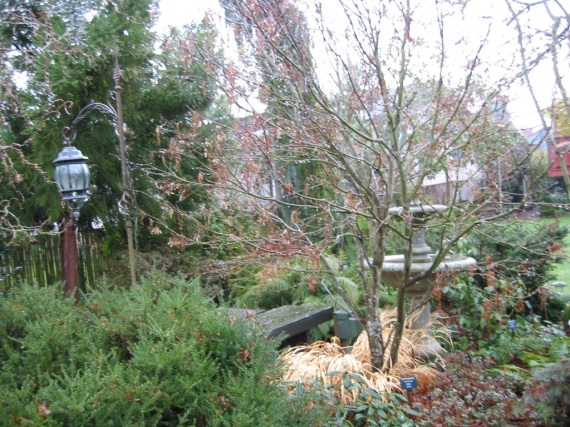
When I turn to my right I see the Yew Pine in the foreground with the hanging light above it. The reddish brown trunk to its left belongs to the Radicans Sugi (Cryptomeria japonica “Radicans”). It’s like the Elegans in size now but is definitely not pettable. It gets bigger too – up to 55 feet or so they say. The tall dark shape in the background is a Weeping Giant Sequoia (Sequoiadendron giganteum “Pendulum”). It’s grown over 35′ tall it 10 years, and is the tallest tree we’ve planted.
In the middle foreground is a Red Pygmy Japanese Maple (Acer palmatum “Red Pygmy”). Below are a couple of nice rhodies – Ken Janeck and Ramapo. The light yellow plant is a large clump of Japanese Forest Grass (Hakanechloa macra “All Gold”). Behind the maple is the fountain, which we keep empty in the colder times of the year. It’s raining now so it’s full.
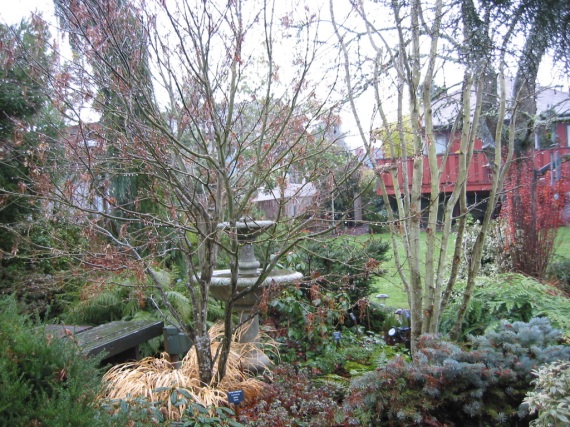
Going clockwise some more you can see the fountain more clearly and a fuller view of the Red Pygmy. I’ve recently pruned it out and I’m very pleased with my efforts. It all seems to be growing the way it wants to and should be a fine strong structure over the years to come. I’ve been reading about Aesthetic Pruning lately. The descriptions sound like what I’ve been doing for decades, more or less. When I was first starting out in the landscape biz I worked with a tree pruner who did “Aesthetic and Therapeutic” pruning. I took it to heart and have tried to emulate his practices ever since. It’s about the health and beauty of the whole garden environment, taking all factors into consideration. Seems like common sense to me.
On the right is a Vanessa Persian Ironwood (Parrotia Persica “Vanessa”). I’ve trained it quite a bit to be very narrow at its base since it tends to spread out as it gets taller and we need to be able to walk around both sides of it. It’s turned out really well and I think it will grow companionably with the big plum behind it. (You can barely see it on the right). The Ironwood turns a spectacular brilliant golden color in the fall. You can see it shining from the back door of the house.
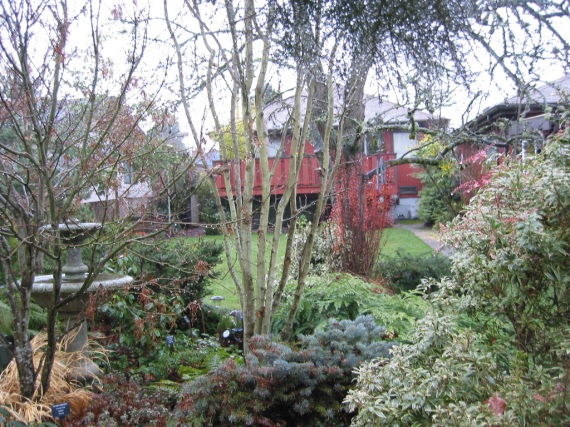 In this one you can see the Plum and why I need to prune the Parrotia away from it. They have to agree to share the air space above them. I think I did a good job of preparing them to play nice. The small blue conifer at the bottom is a RH Montgomery blue spruce. It wants to get bigger than it can here so I have to prune it very judiciously to keep it looking nice and healthy where it is. We’ll see how long I can do that. At the right is a mid-size Lily of the Valley shrub called Little Heath (Pieris japonica “Little Heath”). It has lovely racemes of small white bell shaped flowers in early spring. The leaves are nicely variegated with light green and pink on the margins, especially in spring. It’s another plant in the Heather family.
In this one you can see the Plum and why I need to prune the Parrotia away from it. They have to agree to share the air space above them. I think I did a good job of preparing them to play nice. The small blue conifer at the bottom is a RH Montgomery blue spruce. It wants to get bigger than it can here so I have to prune it very judiciously to keep it looking nice and healthy where it is. We’ll see how long I can do that. At the right is a mid-size Lily of the Valley shrub called Little Heath (Pieris japonica “Little Heath”). It has lovely racemes of small white bell shaped flowers in early spring. The leaves are nicely variegated with light green and pink on the margins, especially in spring. It’s another plant in the Heather family.
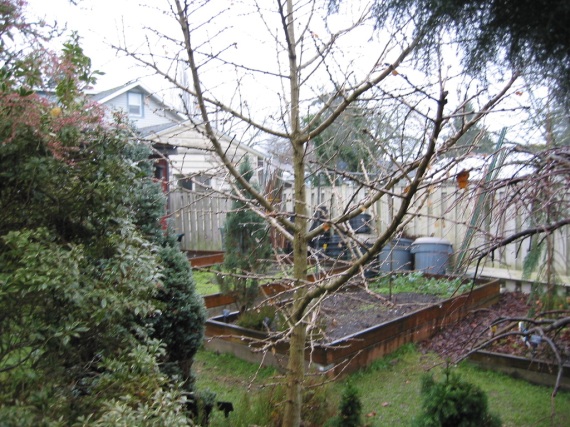
On the left is the Little Heath and in the middle is a Jade Butterflies dwarf Ginkgo (Ginkgo biloba “Jade Butterflies”). It’s so named because the leaves look like little butterflies. Ginkgos are supposed to turn a spectacular shade of golden yellow in the fall. They’re known for it. But for some odd reason ours never does this. lt’s usually a pallid shade of yellow. Except last year when Everything was brilliant it did what it’s supposed to do. ???
Behind the Ginkgo is a snatch of our veggie garden, with a Spaan’s Slow Column Scots pine (Pinus sylvestnis “Spaan’s Slow Column”) at the north end of the veggies where it won’t shade them. You can see a patch of Lacinato Kale at the back. They’ll be in fine shape to start to grow at the very beginning of spring. They overwinter quite well. The blue barrels hold garden soil, compost and fertile mulch for when we need a bit of help with things. It’s handy to keep a bit of each on hand.
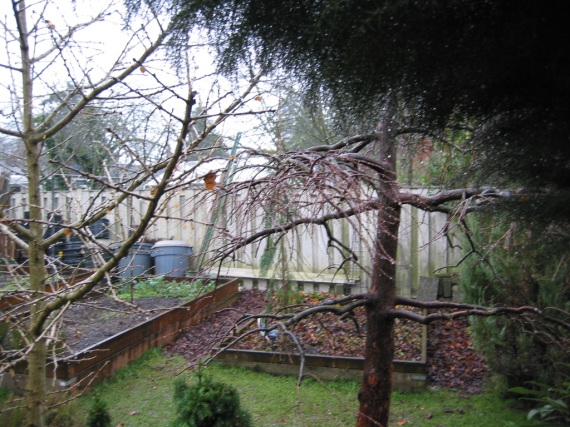
This is the final shot in the panorama. You can see the Ginkgo on the left and in the middle is the Miss Grace Dawn Redwood (Metasequoia glyptostroboides “Miss Grace”). It’s another of the few deciduous conifers that exist. We also have a third – a dwarf Swamp Cypress (Taxodium distichum). (It didn’t show up in this series of photos). Both the Metasequoia and Ginkgo are very ancient trees, formerly found only in the fossil record. It’s nice to have them in cultivation. You can see the strawberry bed better here. It’s not that big but we get quarts of berries. Fresh fruit is so wonderful to pick and eat right out of the garden. Above you on the right is the Elegans again. We’re almost back where we started.

Here we are back at the trunk again. I intentionally pruned up a hollow in this tree so we could stand under it when it rains, which it was doing just now when I took all these photos. I didn’t plan for this to be such a wonderful viewing spot but I’m so glad I “discovered” it one day when I was perambulating the garden, which I try to do every morning. I like to keep up on the doings of all the plants and do bits of “micro pruning” to keep everyone growing happily and harmoniously together. It’s a magical sanctuary but it takes constant, careful work to keep it that way. Having a spot like this where I can overlook the whole garden at once helps me get a more holistic perspective on things. It’s easier to comprehend it all as one large entity.
I hope you enjoyed these panoramic views of the garden. It all feels so much bigger when you’re in the thick of it.
Relaxing on a rainy day,
Steve
14
Sep
Posted by steven1111 in Conifers, Gardens, Nature, Peat Bogs, Sanctuaries, Trees, Unusual Plants, Wet Soils. Tagged: Conifers, Gardens, Peat Bogs, Personal Gardens, Sanctuary, Unusual Plants, Wet Soils. Leave a comment

Swane’s Golden Italian Cypress (Cupressus sempervirens “Swane’s Golden”)
All the conifers I’m showing you today only grow 10-30 feet tall. This particular form of the popular Italian Cypress originated in the Swane Brother’s nursery in Australia in 1946. Since then it’s become very useful as a gold colored accent tree. It grows at a moderate rate up to 30 feet tall, and stays narrow, so it will fit in tight spaces where the height is not a problem. It stays this lovely golden color all year but may be slightly more colorful in summer, as many colored conifers are.

Blue Pfitzer Juniper (Juniperus chinensis “Pfitzeriana glauca”)
This is one of the most frequently planted junipers there is. It grows 10 to 12 feet tall and spreads much wider if allowed to. We keep ours from getting that wide or it would block our whole driveway! I prune it back once or twice every year to keep it in bounds. It grows with this wonderful 45 degree arching habit that makes it look pretty wild, and it is. It’s a very vigorous and fast growing plant with a lovely blue color to it that contrasts nicely with the green ones surrounding it.

Dwarf Bald Cypress (Taxodium distichum “Peve Minaret”)
This is one of my “pettable’ trees, due to its incredibly soft foliage. It’s a unique tree – a deciduous conifer that loses all its leaves in fall after they turn a striking orange-brown. It will supposedly grow to 20 feet or more. Ours is already 13 1/2 feet tall after about 9 years in our garden. It’s gotten way wider that I expected – probably over 12 feet at this point. The species grows in swampy areas in the SE part of the US, and puts on “knees”, or above ground roots, to help hold them up. Ours has a couple of small raised bumps, but they’re not really knees. Not yet anyway.

Blue Arrow Juniper (Juniperus scopulorum “Blue Arrow”)
This is one of the skinniest junipers, or trees of any sort, you can find. They grow 20-25 feet tall but only 2-3 feet wide. It’s considered an improved form of the popular Skyrocket juniper which is also narrow, but gets a bit wider and taller. These are also much bluer, which is a nice contrast to the surrounding plantings. They’ll be a nice screen to give us more privacy.

Van den Akker Alaska Cedar (Cupressus nootkatensis “Van den Akker”)
Another very narrow tree that might even be skinner than the Blue Arrows. It grows up to 25 or 30 feet tall but barely a foot or more wide, tho it throws out side branches that are wider from time to time. I know it’s a bit hard to see here because it’s surrounded by so many other plants. I expect it to tower over the others in time but now it’s sort of hiding behind them.

Beanpole Hybrid Yew (Taxus x media “Beanpole”)
This is cross between the English and Japanese yews. It combines the utility of the English yews with the greater hardiness of the Japanese species. It will eventually grow 10 or 12 feet tall but will stay very narrow (do you sense a theme here?…). It will only get a foot or two wide. It’s poisonous in all its parts, especially the bright red berries it has on it now in September. It’s growing quite fast – well over a foot a year. It’s a lovely dark green accent for our path of conifers along the garden.

Spann’s Slow Column Scots Pine (Pinus sylvestris “Spaan’s Slow Column”)
Scots pine has so many cultivars! We have two very different ones in our small garden. This one will stay very narrow and will only get 15 or 20 feet tall, if even that. It grows very slowly so it’ll take it awhile to get that tall, but it puts on small cones even at this young age, which is very cool. I like the blueish color of the needles. Another skinny accent along the garden.

Golden Spire Western Red Cedar (Thuja plicata “Daniellow”)
This is a beautiful golden form of our native Western Red Cedar – the tree that’s probably most symbolic of the Pacific Northwest. The species is used by the indigenous people here to make just about everything they need – from longhouses to canoes, to clothing and hats, to ceremonial uses and even medicines. This golden form stays this brilliant color all year long, but is brighter in the full sun it’s growing in and in the summer. Another narrow tree, it will grow to 20 or 30 feet tall but only 3 or 4 feet wide. The golden color is a beautiful accent among the green of the other conifers here.

Skyrocket juniper (Juniperus scopulorum “Skyrocket”)
I alluded to this tree earlier when I was talking about the Blue Arrows. This is the original skinny juniper that was supposed to be the skinniest of them all, until the Blue Arrows came along that is. This one is wider and taller than the Blue Arrows and grows a bit faster from my observation. It’s a nice gray-green that sort of melds into the surrounding area and provides a nice vertical accent by the gate here. So far it’s thin enough that it doesn’t block the gate, and I hope it stays that way!

Oregon Green Austrian Black Pine (Pinus nigra “Oregon Green”)
I know it’s a bit confusing to call this a green pine, that is also a black pine, but that’s the way they named it. It was “discovered” in a nursery in Oregon which accounts for the Oregon part, and of course it’s green, so I guess that’s why. I’d have focused on the extremely white candles you see here in spring. They open up to stiffly persistent needles that stay on the tree for years. It has many cones which fall and line the front walk. I love walking by it on the fallen needles and cones.

Diana Contorted Japanese Larch (Larix kaempferi “Diana”)
They say this tree will max out around 30 feet, but I suspect it may get even taller. l’ve never seen a large one, only photos, so we’ll just have to wait and see. It’s about 20 feet tall now, after 5 years growing here – once putting on 4 1/2 feet in one year! It doesn’t have that far to go to get there. It’s another deciduous conifer that loses all its needles after they turn a brilliant golden orange color in the fall. It doesn’t provide much shade yet but it’s still a wonderful tree overhanging the small deck in the back of the garden. The branches all twist and twirl around themselves, thus the contorted part in the name.

Black Dragon Japanese Cedar/Sugi (Cryptomeria japonica “Black Dragon”)
This is one of the hundreds of cultivars of this tree, of which we have several. It’s the national tree of Japan. We call it Japanese Cedar but, they call it Sugi. The species and some large cultivars are very important timber trees. The species grows well over a hundred feet tall, and we have one cultivar that gets over 50 feet. But this little one here only grows 10 to 20 feet tall, and it takes it some time to do that. They call it Black Dragon for its dark needles. It’s definitely not one of my “pettable” ones since its needles are very stiff and hard to the touch. It grows fast in youth but it’s slowed down now to only a few inches a year. It won’t get too wide but I’ll still need to prune it to fit in someday as it and the ones next to it grow.
These are the medium sized conifers we have growing here in our little Nature Sanctuary. They fill a need for evergreens that don’t get too wide but still have some height to them. They love the rich, wet, acid soils we have here in our little Greenwood peat bog – perfect for most conifers. As you surely noticed many of these are rather skinny things, which means a lot of them can fit in the garden without taking up too much floor space. Given the small size of our garden this is a very nice feature, and one for which I’ve specifically chosen them. We do have some larger conifers, but I’ll wait to show them to you in a future post. For now I hope you’ve enjoyed this presentation of the various mid-sized conifers we grow here.
Happy Autumn!
Steve
21
Aug
Posted by steven1111 in Awards, Flowers, Gardens, Nature, Peat Bogs, Pruning, Sanctuaries, Trees, Unusual Plants, Wet Soils. Tagged: Awards, Flowers, Gardens, Nature, Peat Bogs, Personal Gardens, Pruning, Sanctuary, Wet Soils. Leave a comment

August 2015 – home from the nursery

August 2015 – Just planted

October 2015

March 2016

May 2016

November 2016

February 2017

May 2017

October 2017

February 2018

May 2018

October 2018

January 2019

May 2019

August 2019 – Today
The Persian Ironwood tree (Parrotia persica) is native to Iran, or Persia, as it was originally known. This is a selected variety introduced in England in 1840. It’s much more narrow growing than the species, which can get quite wide, tho not that tall. They’re wonderful 4 season trees, with tiny red flowers in late winter and early spring. Then in summer the scallop shaped leaves come out with reddish tinges on the margins and very lush growth. By fall it turns spectacular shades of bright golden yellow, which you can see in some of these photos here. In winter the bark is the beautiful part, turning a mottled green, cream and tan as it ages. The form is also quite lovely in winter when you can easily see its branching patterns.
This is a relatively columnar form of this tree and is supposed to grow 20 – 40 feel tall and 10 – 20 feet wide. I’ve pruned the base of it to keep it narrow so it will fit in between the paths where we’ve planted it. It’s been growing by leaps and bounds every year. You can see how large it’s gotten in just 5 growing seasons, and the summer isn’t over yet so it’s still growing now. It’s pretty cool to see it put on 3 – 4 feet of growth each year, tho some websites say it’s slow growing. Not for us! At first the foliage just flops all over itself and falls down into the paths. But as the summer progresses the branches pull themselves back up into a more narrow form. I had to restrain myself to keep from pruning it the first year as I watched this habit develop. Sometimes it’s best to just wait and see what a tree will do before you lop off a branch or two. You can’t put them back on you know…
Vanessa, which was named for a colorful species of butterfly, has received the prestigious Award of Garden Merit from the Royal Horticulture Society, and is also a Great Plant Pick chosen by the Elisabeth Miller botanical garden here in Seattle. It’s in the same family as the witch hazels, but the flowers on this one don’t have any fragrance. I’ve never seen a really large specimen of this tree, but I’ve seen lots of photos, and it’s really striking as it gets bigger. As usual I didn’t really give it quite as much room as it might like so I’ll have to continue to do some aesthetic and therapeutic pruning on it as time goes on. Right now I’m training a couple of the main trunks to head out from under the canopy of the plum next to it so it will grow up and over the plum and the two won’t fight each other as much. It’s challenging to do this training but it’s also a lot of fun figuring out just how to get everyone here to get along with one another.
This tree likes the moist peaty soil we have in our little Nature Sanctuary here in Greenwood. It holds the water well but also drains nicely so there’s no worry about over watering. I also don’t have to give it nearly as much water as other gardeners here in Seattle say they need to do to establish their trees. I have a system of counting to a certain number based on how many gallons of water the hose puts out per minute. Yes, I measured the output of the hose to do this. Sometimes it gets a little bit nuts to count out all the plants to be sure they get enough water. At times I can’t seem to stop myself from counting everything I run into! It’s useful to help the plants to establish well, but it makes me a little bit crazy… 😉
Happy gardening!
Steve
28
May
Posted by steven1111 in Dwarf Plants, Ferns, Gardens, Groundcovers, Peat Bogs, Sanctuaries, Unusual Plants, Wet Soils. Tagged: Dwarf Plants, Ferns, Gardens, Peat Bogs, Personal Gardens, Sanctuary, Unusual Plants, Wet Soils. 4 comments

Maidenhair Fern – Adiantum aleuticum

Ghost Fern – Athyrium x Ghost

Korean Rock Fern – Polystichum tsus – sinensis
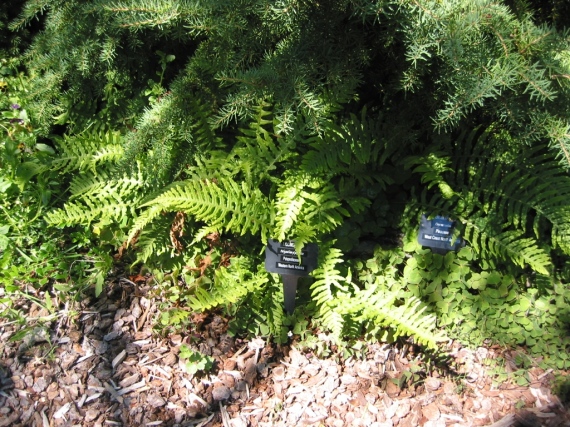
Licorice Fern – Polypodium glycyrrhiza
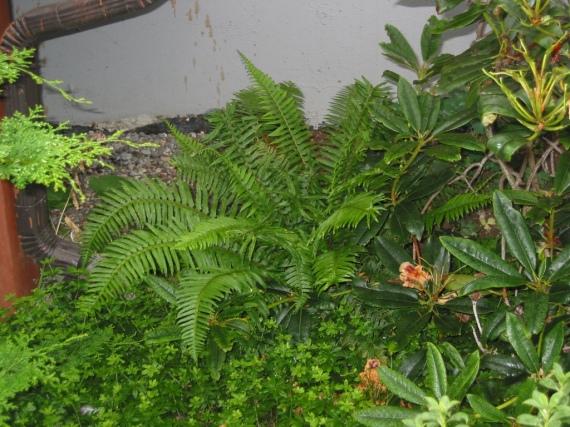
Western Sword Fern – Polystichum minutum

Auriculate Lady Fern – Athyrium otophorum
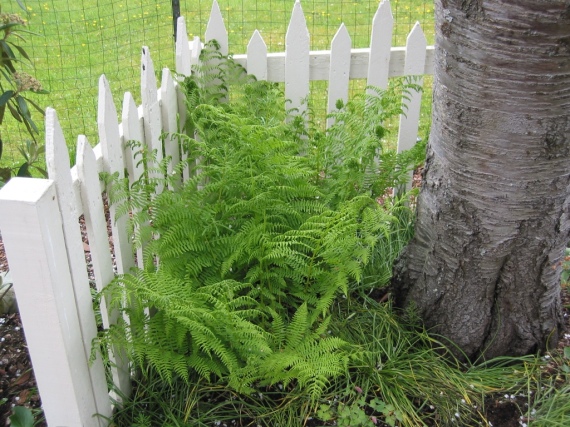
Lady Fern – Athyrium filix-femina

Soft Shield Fern – Polystichum setiferum “Diversilobum”

Japanese Painted Fern -Athyrium nipponicum “Pictum”
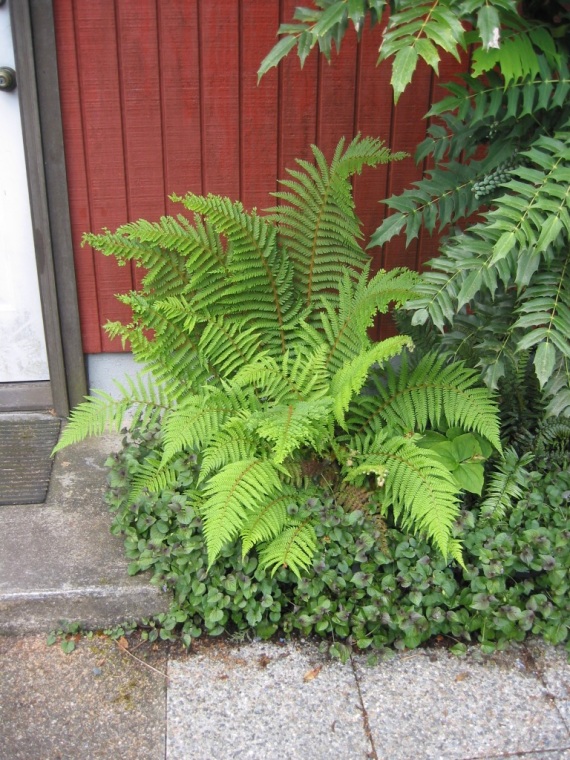
Alaska Fern #1 – Polystichum setiferum

Japanese Tassel Fern – Polystichum polyblepharum – Left side by tree
Alpine Water Fern – Blechnum penna-marina – All thru the middle

Silver Saber Fern – Polystichum xiphophyllum

Unknown Fern #1

Unknown Fern #2

Robust Male Fern – Dryopteris filix-mas “Robusta”

Alaska Fern #2 – Polystichum setiferum

Dwarf Crisped Golden Scale Male Fern – Dryopteris affinis “Crispa Gracilis”
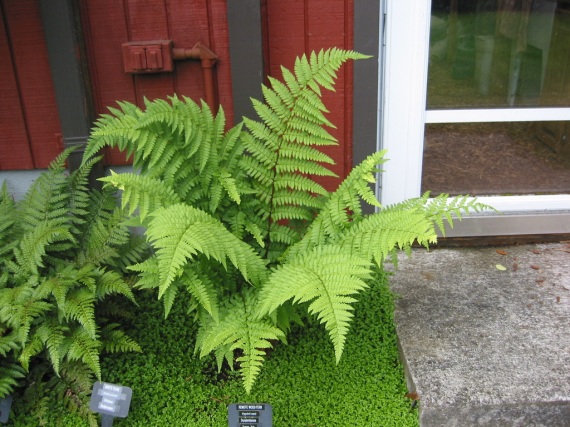
Remote Wood Fern – Dryopteris remota

Mackino’s Holly Fern – Polystichum mackinoi
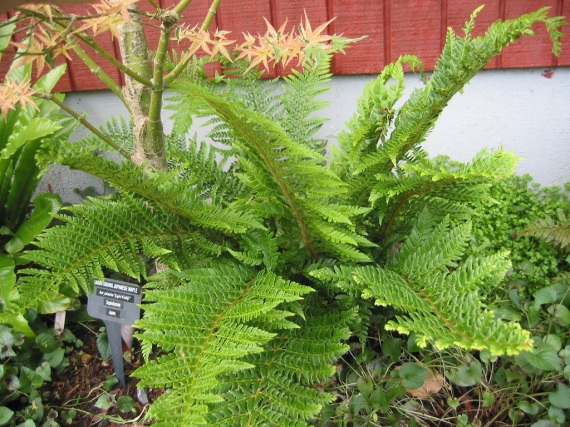
Hard Shield Fern – Polystichum aculeatum

Deer Fern – Blechnum spicant

Hart’s Tongue Fern – Asplenium scolopendrium
You might think I have too many ferns, but how can you have too many of these delicate and diverse wonders in your garden? They seem to thrive here in our Nature Sanctuary in the wet soils of this peat bog we garden in. I’ve included some of my favorites that are no longer with me, unfortunately. Sometimes they just die on you – for no apparent reason. Very frustrating. But enough of them live and thrive to make me happy.
Several of these are along the garage wall in the “Fern bed”, while others are scattered throughout the garden. I count 23 different ferns here, of which 19 still live. Not a bad record, tho I’ve replaced a few over the years. I had to include them all because they’re just so cool! BTW – if you recognize either of my Unknown ferns (I lost the labels!) please feel free to enlighten me as to their names – Thanks!
I hope you’ve enjoyed this display and may have found some ferns you’d like to put in your own garden.
Ferns Rock!
Steve
17
Mar
Posted by steven1111 in Conifers, Gardening, Gardens, Nature, Parks, Peat Bogs, Pruning, Sanctuaries, Trees, Unusual Plants, Wet Soils. Tagged: Conifers, Cryptomeria, Gardening, Gardens, Nature, Peat Bogs, Personal Gardens, Pruning, Sanctuary, Sugi, Unusual Plants, Wet Soils. 4 comments

Cryptomeria japonica “Radicans”, or Radicans Sugi as it’s called in Japan, is one of my favorite trees in our little nature sanctuary, and one of the two tallest growing trees we have. This one will eventually get to 45 or 50 feet tall in time, and not too long a time really, as you can see in the following pictures. It grows very fast and loves the wet peat soil we have here in our garden. We got this tree in a big box from a nursery in Oklahoma. I couldn’t find it locally so I went on the web. It was 4’11” tall in this tiny pot it came in. It’s gotten a lot bigger since then. It’s one of the larger growing of the several hundred cultivars of Cryptomeria.
Cryptomeria, or Sugi, is the national tree of Japan, and grows well over 150 feet tall in its native habitats. One story of it I like is that of a feudal vassal who wanted to honor his Lord, but didn’t have the funds to do it the way he wanted to. So he planted an avenue of these trees that was several miles long. Today it’s a prized site of huge trees for visitors to marvel at. This tree is quite unique – the only species of its genus (maybe – there’s some disagreement among botanists). It used to be in the same family as the Redwoods, which it resembles – especially the Giant Sequoia. In fact it still is, but now it’s the Cupressaceae, instead of the more descriptive one of Taxodiaceae (my bias.) They use the bark to side temples and shrines, as well as using the wood for all sorts of construction.

This is taken shortly after we planted it in June of 2013. It looks so tiny there now but even in its first year it grew well over a foot and 1/2, not bad for a new planting. It replaced an old cherry tree that died on us, a very sad event, so we wanted a fast grower to fill the spot left by the cherries absence.

This was taken in November of the same year, 2013, and shows the growth it put on in that time. I left all the lower branches on at first to give the tree as much sunshine as it could get in its first year.

This is February 2014, after I pruned it up to begin the process of raising the skirt so we could eventually walk under it. I haven’t had to prune is since then, but will surely have to at some point in the next few years.

This was taken in July of the same year – 2014 – and you can see how much it’s grown. It actually put on 3 feet of growth that year. It totally amazed and thrilled me, as you can imagine. It’s living up to its reputation as a fast growing tree.

This is in the same year, but in October, after it’s put on even more top growth. It’s about 9 1/2 feet tall now.

I took this picture in May of 2015 – the year after the previous photo. It’s beginning to put on the seasons growth. It’s getting wider now and filling out more, and the skirt is still the same height as when I first pruned it up.

It’s much fuller now in August of 2015. Amazing how much it’s grown in just 3 months isn’t it? It’s beginning to look more like a real tree.

This is taken in late winter, February of 2016. It hasn’t grown much since the last photo but you can see the trunk better. It’s still pretty skinny for such a tall tree, but it’s getting thicker every year.

A few more months and it’s added more growth by the time this photo was taken in July of 2016. Look at it next to the light post and you can see it grow as the photos go on.

See what I mean about the post? This is just 2 months more growth in September of 2016. It’s starting to look a lot fuller now and the whole area is filling out along with it.

This is taken from a different angle and shows the undergrowth well. This is in July of 2017, just over a year or so ago. I’m being continually amazed by the growth this tree is putting on. It’s getting way too big for me to measure it with my measuring stick anymore, but I’d guess it’s at least 16 or 17 feet tall by now.

By October of 2017 it’s even taller – probably 18 or 20 feet now. That means it’s grown an average of 3 feet a year for it’s 5 years of life here in our garden. Wow… When I stand next to it and look up it’s starting to feel like the top is really far away now.

Here it is last month – February 2018. It hasn’t really grown much since the last photo but it has all sorts of pollen on it that scattered all over the place during the winter. In Japan it’s a prime source of allergies, so I hope it doesn’t do that too badly to us. Both of us have allergies to things like this, but that’s the price you pay for such sylvan beauty!

No, this isn’t our tree. It’s a specimen of the actual species of Cryptomeria japonica that’s growing in the lawn of the Quinalt Lodge in the Quinalt Rain Forest on the central coast of Washington. We were there just last week and of course I had to take a picture of this tree. The Lodge was built in 1926 and the tree was planted soon after, so it’s about 90 years old now. We figure it’s about 80 or 90 feet tall, maybe more. Not quite as tall as the native spruces and Douglas firs, or even the redwoods they also planted, but it’s still magnificent. Ours won’t ever get this big, more like half of it, I hope…
So that’s some of the story of this beautiful tree. I’m continually impressed with the beauty of it and how fast it’s taken its place in our landscape. The cherry was a big loss and now this tree is slowly filling that gap. It’s not that big yet but it will get even bigger than the cherry was so it’ll do it quite well in time. It’s only supposed to get 15-20 feet wide, and I hope that’s true, but it’ll probably get wider. You just can’t trust the labels, or even the descriptions on the websites. Not a problem tho. It’ll get the size it’ll get and that’s just the way it is. Might as well love it…
Some day I’ll do a post on all the Cryptomerias I have here in our little Nature Sanctuary – a dozen or so of them now – and show how varied they can really be. But this will do for now. Thank you for visiting me and I hope you enjoyed this exploration as much as I enjoyed presenting it.
For all the Sugis everywhere,
Steve
3
Jul
Posted by steven1111 in Conifers, Dwarf Plants, Gardening, Gardens, Peat Bogs, Unusual Plants, Wet Soils. Tagged: Dwarf Plants, Gardens, Peat Bogs, Personal Gardens, swamp cypress, Unusual Plants, Wet Soils. 12 comments
-
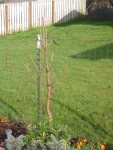
-
4/5/11
-
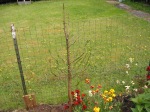
-
5/30/11
-

-
6/24/11
-

-
7/9/11
-

-
11/18/11
-

-
6/16/12
-
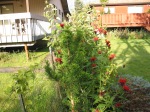
-
7/19/12
-

-
11/12/12
-

-
7/11/13
-

-
8/10/13
-

-
9/16/13
-

-
10/30/13
-

-
11/13/13
-
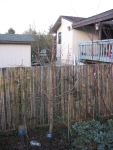
-
2/14/14
-
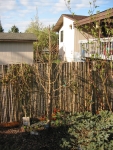
-
4/9/14
-

-
4/23/14
-

-
5/28/14
-

-
7/3/14
I wrote a profile of this plant a year and 1/2 ago, but it’s grown so much since then and all I posted then was a single shot, so I thought I’d do a pictorial journey thru this plant’s life here in our garden. We planted it in early April 2011 so it’s only been growing for 3 years and a bit. It grows pretty fast for a dwarf. This is a cultivar from Holland of the Swamp Cypress that grows all over the Southeast of the US and is endemic to the swamps and wet places of the region.
As a tree it gets quite big, but this little dwarf will only get to some 10 feet by 3-4 feet , or so they say. It’s already that wide or wider but only about 6-7 feet tall so far, tho it’ll be taller in a couple of months as the top grows. I’ve noticed an interesting thing about this tree, and several other conifers, that intrigues me. It starts to put on growth at the bottom of the tree first and then works its way up to the top after several weeks of growth. It’s in that stage now where it’ll put on a new top, and it should put on a foot of growth there if it does what it did last year, which is no definite indication but hopefully it will do so. It also tends to put on several tops and then reduce them to just one. I’d heard that you had to prune the extra ones out, but that’s not true. The trees know what to do I’ve noticed so I just let them do it. Sometimes it’s best Not to prune…
I did a lot of research on this tree, as I outlined in my previous post I did on it here: https://gardeningingreenwood.wordpress.com/2012/11/28/the-persistence-of-greenery/. I’ll try not to repeat too much of that post but I want to talk about it a bit. It’s a unique plant in that it’s one of only a few conifers that lose their leaves in the fall and renew them in spring. The others are the Larix, or Larch, the Metasequoia, or Dawn Redwood, and the Ginkgo, or Maidenhair tree. There’s some debate about whether or not the Ginkgo is really a conifer right now but I like i that way so I’ll include it anyway. I have a Metasequoia and the Ginkgo in the garden as dwarfs but no Larix, yet… I haven’t found a dwarf of it and I wouldn’t have space to put it anyway so it may not be in my agenda. But we’ll see.
This plant loves wet places to grow as I mentioned and that’s the primary reason I planted it here. This is a really wet spot in this peat bog we garden in, and we lost a few other nice plants here before I did the research to find this one that loves having its feet wet. It’s thriving where it is so I think I made the right choice. I also planted a creek dogwood and a choke cherry along this fence line as they also love the wet soil, as do the dwarf Cryptomerias along the edge of the bed. The only original plant I put in here that survived is the Inverleith Scotch Pine and I’ve read that Scotch pine like it a bit wet too so that makes sense. It’s doing great too and it is now over 10 feet tall, it’s supposed height, tho some say it gets much bigger. I assume it will.
This plant is one of my “pettable” trees because it has such gloriously soft foliage and is so nice to touch and stroke. The others are the Metasequoia and the Cryptomeria elegans that both have very soft foliage and don’t feel like most conifers at all. I’m fond of touching the plants I grow just to get a”feel” of them and so I notice little things like soft foliage on conifers. It’s a treat to feel them. I have a few really prickly plants too, like the Oregon grape and Mahonia charity and even the Osmanthus goshiki, so it’s nice to have others that you can actually touch, tho the others are so soft when they put on their new growth it’s hard to imagine how tough they will become.
I’ve arranged these pictures in chronological order so you can get a sense of how fast this tree really does grow. I’m really amazed by this and it’s good for me as I’m pretty impatient at times and it’s hard to wait to watch plants grow slowly when you want them to get big fast. It’s a trap of course and it’s a joy to watch the Chamaecyparis obtusa Nana only putting on about a 1/16″ of growth a year. You can just see it on the tips of the branches. The same is true of many other dwarf confers, like the Cryptomerias Tansu, Pygmaea and Vilmoriana. They all just barely let you know they’re growing and it’s so cool to know they are and yet don’t show it much. Slow has it’s place just as fast does.
So I hope you found this enjoyable to see how this lovely tree grows so nicely and fills out so well as time goes on. If it does grow this much in only 3 years it’ll become a larger tree in time I think, despite the things they tell you on various websites when you look them up. I’d love it if it did get bigger than its supposed 10 feet but if it doesn’t do that I’ll be happy too of course. I just have to keep the creek dogwood next to it away from its top so it can get there. I have to do a bit of pruning to keep all the plants in their spaces and be cool with one another in their growth habits. It’s a nice challenge to grow this garden and I’m so glad you stopped by to see some of it.
Good growing to you!
Steve
13
Jun
Posted by steven1111 in Gardening, Gardens, Nature, Parks, Sanctuaries, Wet Soils. Tagged: Gardens, National Parks, Nature, Parks, Sanctuary, Wet Soils. 10 comments
Louie and I recently took a trip to Yellowstone and the Grand Tetons National Parks. We came back filled with wonder and about a zillion pictures of our visit. This time I’m focusing on scenes of steam and water and the amazing mud they create in wondrous colors and forms. The whole land is just bubbling and gurgling with underground steam yet to be released. As one fellow traveler remarked, we were taking pictures of a Lot of steam! It’s truly an awesome place and we had a wonderful time there.
Yellowstone is the first National Park in the whole world and the biggest in the contiguous United States. It’s absolutely huge and contains a 30 x 45 mile wide caldera from a giant volcano that is still active and spewing forth steam daily in its many geysers, more geysers than anywhere else in the world. There are so many it’s impossible to see them all but we tried to see a good cross section of them, tho we stayed on the main roads and paths rather than going into any back country areas.
I’ve included a few of the trail signs that tell some of the story of the park and the geysers and the constant smell of sulphorous steam that permeates the landscape as you wander around the various hot spots. Some places are so dangerous that you have to stay on the boardwalks the Park Service has constructed because otherwise you’d fry your feet off if you tried to walk onto the ground. It’s a little terrifying to say the least.
I’m not going to talk much and just let the pictures tell their own stories here today. I wasn’t able to keep track of just which geyser I was shooting at any given time so it’s a jumble of places that we happened to visit in no particular order, tho of course the first geyser shown is of Old Faithful at its highest point when we we there. It was pretty cool alright. Lots of visitors for so early in the year too.
I’ve always loved National Parks because of the natural beauty of course, but also because of the great diversity of people who travel in them and the many languages you overhear on your walks. They are truly places that welcome the World in and it’s so cool to be among so many different types of people, all inspired and in awe of the natural sights that the different parks have to offer.
I hope you enjoy these pictures. I’ll post more of other things over the next bit of time. I haven’t been posting much lately due to some serious depression, but I’m doing much better now. As some of you know, I live with Bipolar Disorder and sometimes it takes me over and I can’t function very well, and writing is impossible. I’m still a bit shaky so I’m starting off slow. I’m glad to be back…. 🙂
peace,
Steve
1
Apr
Posted by steven1111 in Dwarf Plants, Gardening, Peat Bogs, Unusual Plants, Wet Soils. Tagged: Dwarf Plants, Gardening, Peat Bogs, Unusual Plants, Wet Soils. 26 comments
-

-
Ginger Patch
-

-
Ginger Flower
-

-
Ginger Plant
-

-
Dutchman’s Pipe
-

-
Dutchman’s Pipe
-

-
Dutchman’s Pipe
The Aristolochiaceae is a very interesting family. To me the two most well known members of this family are both growing in my back yard right now. Both of them have extremely fascinating flowers. I’ve tried to give you a glimpse of what they look like here. Both are very unique and unusual. I like that a lot about them. And they’re also useful.
The first is the Wild Ginger, or Asarum caudatum. It grows wild in the wet forests of the Pacific Northwest and there’s also a related species called Asarum canadensis that grows in the middle of the country and north into Canada, as the name implies. Dan Riegler at Apothecary’s Garden has some great recipes on how to make wild ginger candy. You can see his recipe for his candied Ginger here: http://apothecarysgarden.com/recipes-2/candied-wild-ginger-a-recipe-from-fresh/.
My patch doesn’t look that great right now at the end of winter and is just starting to put on new growth. The flowers can barely be seen in a couple of these shots and you can see how very weird they look. I love the deep burgundy color and the “wings” it has on the sides of the flowers. I’m not sure what they’re called but they look cool to me.
The other notable plant in this family is the California Dutchman’s Pipe. I showed it earlier when it was just starting to bud out and promised I’d show it in bloom, so here it is. I’ve tried to get shots of the whole vine in one picture with others of a closeup of the flowers themselves. They’re quite interesting and unique aren’t they? They really do look like a pipe don’t they?
They call it insectivorous even tho they don’t actually eat insects. They do entice them to crawl down into the flowers tho and pollinate them and then they release the bugs to go on their way. A very civilized system of pollination I’d say. These grow as tremendous vines in wetlands in California. I’ve seen them there and their swamps are very cool and weird too. They can cover large areas and I saw a particular place in their range where the Forest Service had built a walkway over the water so we could walk among them. Very cool.
So that’s it. A simple post for a change. Just wanted to show these extraordinary plants while they were in bloom and looking good. I don’t have enough ginger to really try Dan’s recipe yet but some day I hope to be able to. It sounds too good to miss out on and having unusual foods in my own garden is really wonderful. I hope you’ve enjoyed this mini tour of some unusual plants.
Happy gardening!
Steve
18
Mar
Posted by steven1111 in Conifers, Gardening, Nature, Parks, Sanctuaries, Unusual Plants, Wet Soils. Tagged: environment, Nature, Sanctuary, Unusual Plants, Wet Soils. 18 comments
-

-
Sitka Spruce
-

-
Spruce Info.
-

-
Western Red Cedar
-

-
Western Red Cedar
-

-
Douglas Fir Stump
-

-
Douglas Fir
-

-
Douglas Fir
-

-
Douglas Fir
-

-
Western Hemlock
-

-
Spruce, Fir, Cedar, Hemlock
-

-
Mixed Conifers
-

-
Red Alder
-

-
Vine Maple with Cedar
-

-
Shore Pine
-

-
Coast Redwood
-

-
Cryptomeria japonica
-

-
Cryptomeria elegans
-

-
Cedrus atlantica
The Quinalt River valley and rain forest is home to some of the world’s largest trees. Some of them are the biggest trees outside of California where the Coast and Giant Sequoias grow. In this one valley are 6 of the largest trees, either in Washington State or in the whole world for some species. These include the Western Red Cedar, the Sitka Spruce, the Yellow Cedar, the Mountain and Western Hemlocks and the Douglas Fir.
In the first picture here you can see the world’s largest spruce tree. It’s a Sitka Spruce, or Picea sitchensis, as the sign tells and is absolutely huge. I tried to get as much of it in the picture as possible but it’s just too tall. It’s located just a short walk from the Ranger Station and the Quinalt Lodge in the heart of the river valley so it’s an easy one to get to and marvel at.
The next picture is of the world’s largest Western Red Cedar, Thuja plicata. We didn’t even try to shoot the top of this because the forest was too dense to see it but you can tell it’s a giant from the size of this trunk. It’s so ancient feeling. I’m not sure how old it is but it’s 174 feet tall and has a circumference of 63 feet. It’s on the north side of the lake and took some hard hiking to get to, as it was very wet when we took this shot last year. But it was worth the climb… The shot after that shows a large cedar from the top down. It’s not a record breaker but it’s still large and gives you an idea of how they grow.
The next shot is an unusual one and one we never thought we’d see. It’s in a subdivision near the ocean and is a Dougls Fir trunk that is estimated to have been 1000 years old when it was cut down at the turn of the last century. That’s the 20th century btw… so it was cut in the late 1800’s or early 1900’s. They plan to hollow it out and cover over the inside to make it a tree house and a history lesson for the people who see it. It should be amazing to see when it’s done.
If you look closely at the left side you can see notches cut into the trunk. This is how they cut down these giants. They cut chunks out and hammered in planks which they stood on to saw thru the trunk many feet in the air as the bole of the tree was too wide to cut otherwise and was useless lumber. There are huge stands of these stumps all over the West in forests that have been logged. It’s am ingenious way to cut them down, tho personally I can’t understand the mind of a person who would dare to cut down an ancient being like this tree was. As I said in my last post I’m against logging old growth forests wherever they are. It’s too late for this one but there are many others that need protection.
Next is the trunk of a large Douglas Fir, Pseudotsuga menziesii. Not a record breaker, still the largest one in the world is located in the park near where we hiked. It was too far to make it to it so here are its stats. It’s 302 feet tall and 40 feet around. Huge isn’t the word for it I guess. It’s massive. It’s a tie with one somewhere else I don’t know where, but it may be in British Columbia which also has some huge trees. I took a picture of the trunk close up and then looking up into this tree. The next shot is of the Fir gracing the lawn at the edge of the lake near the Lodge. It shows how a Fir can grow when it’s not surrounded by other trees. Pretty nice, eh?
Next is a Western Hemlock. The largest one of this in the US is here in the Park too. It’s pretty isolated so we couldn’t see it but I wanted to give an idea of how they grow. The biggest one is 172 feet tall and 27 feet around. Not as big as the firs but still large. The Mountain Hemlock isn’t pictured here, but the largest in the world is in a far away part of the park also. It’s some 152 feet tall and only 6 feet in diameter. They stay skinny, which is why I can grow one in my garden…
The final Big Tree in the famous 6 is a Yellow Cedar, which is neither particularly yellow nor a cedar but that’s what they call it. It’s a Chamaecyparis nootkatnensis and is on the north side of the lake. Too far to hike to. It’s “only” 129 feet tall and 37 feet in circumference. It grows from Oregon up into Alaska and is often called Alaska Cedar tho it’s a False Cypress by botanical name. I understand it’s name is in confusion now tho and may have a new genera name soon. We’ll see…
Here are a few of these trees all growing together in one place. In one you can see 4 of these big trees and in the other who can tell? I sure can’t from the picture tho I could at the site. I should have written it down I guess. These show how dense the forest is in the rain forest. Remember that this area gets around 12 Feet of rain a year on average, which means some years they get more! Amazing….
Here’s a large Red Alder, Alnus rubra. Not a giant at all but still quite nice. These cover huge tracts of land in the West and also fix nitrogen in the soil so they improve the soil where they often are one of the first things to come in after a clear cut or fire. Next is a Vine Maple, Acer circinatum, a large one at the base of a large cedar. These are also all over the rain forest and grow sorta like a Japanese maple. I have one I just planted in my garden too. The next is a simple shot of a Shore pine, Pinus contorta, which covers vast areas of the coastline all along the way from Oregon up to Washington and further north to BC. This is in someone’s garden in Moclips but it was a nice specimen I wanted to show you as its covers so much of the forest.
The last 4 shots are of trees that some human planted back in the day when the Lodge was first built in 1937 or so. I’m not sure just when they planted these there after that but I assume it was soon so figure these are only 75 years old or so and they are huge trees already. The first is of trunks of a few Coast Redwood that are probably 8 feet across and 0ver 100 feet tall, right out front of the Lodge. There are many more in back.
The next shot is of the Cryptomeria japonica that I have many cultivars of in my garden. This is the species and must be 80 feet tall or more. I’m not great at judging heights… These have large trunks also and this is a clump of 5 trees you’re seeing here. I was surprised to be able to see this particular tree in the park. I didn’t know it was used so long ago in cultivation in such a place, but that just makes it more interesting to me…
The next is a large specimen of a Cryptomeria japonica elegans, which I also have in my yard. I’ve never seen one this big and was amazed that it actually gets this tall and wide. All the books say so but seeing is believing and it’s different in person. This is in someone’s front yard and I was thrilled to see it as we drove by and made Louie turn around so I could get a shot of it. I’m glad I did as it reminds me of mine as it grows.
Finally is something I’m assuming is an Atlas Cedar. A true cedar, Cedrus atlantica, not the Western cedar which is actually an arborvitae, or Thuja. This tree must have been planted here too and it’s probably 80 or 90 feet tall. I’m not 100% certain of my identification but I’m pretty sure that’s what it is. It’s native to the Atlas mountains in N. Africa and elsewhere in the mid east. Related to the Deodar and Lebanese Cedars, all Cedrus species.
I hope you’ve enjoyed this tour of the Big Trees of the Rain Forest. I’m so amazed that in this one little valley there could be all these huge trees. Obviously the rainfall is something they all love and the deep rich soil of the Olympic mountains feeds them well so they can reach record proportions. I feel lucky to have seen the ones I saw and hope that maybe we’ll hike in to see some of the others some time, tho as I get older that seems less likely. Hiking is hard work… 😉
Lovin’ the Big Trees,
Steve
16
Mar
Posted by steven1111 in Conifers, Ferns, Gardening, Nature, Parks, Sanctuaries, Unusual Plants, Wet Soils. Tagged: Dwarf Plants, Nature, Parks, Sanctuary, Unusual Plants, Wet Soils. 19 comments
-

-
Entering the Reservation
-

-
Quinalt Lodge front
-

-
Rain Gauge
-

-
Back of Lodge
-

-
Fireplace
-
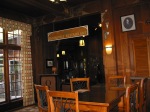
-
Entrance to Dining Room
-

-
History of Building
-

-
View from the Terrace
-

-
Licorice Fern
-

-
Edge of the Woods
-

-
In the Forest
-

-
Willaby Creek
-

-
Deer and Sword ferns
-

-
Deep Woods
-

-
Lichen
-

-
Nurse Log
-
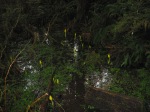
-
Skunk Cabbage
-
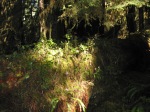
-
Nurse Log
-

-
Nurse Stumps
-

-
Looking Down
-

-
Quinalt Lake
As I mentioned in my last post we just spent a week at the ocean near the Quinalt Indian Reservation. One day we took ourselves into that forest and to the Lodge there for lunch and to tour the area. The first shot is entering the Reservation tho most of the time we were slightly out of it on Park land. The first few shots are of the lodge. It was built in 1937 starting in early June and finished by late August the same year. Teddy was coming and they had to have suitable accommodations.
In 1937 Teddy Roosevelt visited the Olympic Rain Forest and was met by hordes of school children holding signs saying “Please Mr President, we children need your help. Give us our Olympic National Park”. Roosevelt said it was the “most appealingest appeal” he’d ever heard, and in June 1938 he created a 648,000 acre National Park and made it part of the National Park system. It’s now over a million acres. It celebrated its 75th anniversary last year. The lodge is at the southern most tip of the Park at the southern end of Lake Quinalt.
Looking at this structure it’s amazing to imagine them building it in under 3 months back in 1937 without the power tools we rely on today. It’s s a huge place as you can see from the picture that shows it from the back outside on the lawn. The rain gauge on the terrace shows that the highest rainfall they ever had was around 14 feet. Last year is it was 12 1/2 or so. It gets very wet here…
There are a couple of shots of the interior of the Lodge, showing the fireplace that takes 4 foot logs and the entrance to the Roosevelt Restaurant. The picture of all the photos shows the construction of the Lodge from start to finish. It’s hard to read of course but you can see the building going up fast and beautifully. The view from the Terrace shows the Lake as you see it from the dining room windows where we ate lunch. It was amazing and we saw a bald eagle perched in the top of the big Fir at the lawns edge.
Next we start to go on some walks and first encountered this tree covered with Licorice fern which I have growing in my garden. It does this thing where it grows on trunks of trees all over, even here in Seattle, but this was a fine stand of it. Next is a shot of the edge of the woods looking into the depths of the forest. Then we went on a hike on a Nature Trail and took a lot of shots along the way.
Willaby Creek runs under the road here and we can see it as it falls near the bridge and runs under it. It’s a fast flowing stream that gets pretty big in the winter season as it is rushing now. The trail follows its canyon for quite awhile till it turns back to the start of it. There are many fine ferns to see all over. Here are the Deer fern and the Sword fern, two common NW natives that I have in my yard at home. Here they cover the whole area. Quite a sight to see.
Once again we look into the deep woods and see as far as we can into them. It’s not easy as these woods are so dense. I’d never want to bushwhack in them, tho I have. It’s too dangerous and very wet. Lots of water everywhere here. It makes for a lush forest and lots of good growth. Here’s a shot of some kind of weird lichen someone put on a stump so it could be seen well. I dunno what it is but it’s beautiful up close like this.
Next I show a few nurse logs and stumps. These are decaying trees or stumps that serve as homes for new life. In some cases even big trees start out on these logs and create a new forest that way. It’s fascinating. In the middle of them is a picture of a skunk cabbage patch just starting to grow into its fluorescent yellow. Pretty cool, eh?
Next is another picture looking down into the depths of the forest. It’s just so full of life here it’s amazing how it can all fit. But each plant and animal has its role to play and together they all create this incredible ecosystem that ends with a shot of Lake Quinalt from a nice picnic area near the entrance to the Reservation.
It’s a large lake and only is used by the Native fisher folk now because of all the troubles with non-native invasive water creatures being brought in by outside anglers and boaters. Now only the Tribe can use the lake for fishing and I think that’s a good thing. It’ll preserve it from the encroachment of more of the usual development that has already happened here.
Lots of controversy is brewing out here to keep the Olympics wild, tho some locals want it kept for themselves to log and cut down the forest. You can probably tell where my sympathies lie. I sympathize with the local folks but this is a National, even a World Class, Treasure, and it needs to be protected. I think the Tribe will do a much better job of that and maintaining more of the land will only make more trees safe from the chainsaw.
I hope it happens well for all concerned and that some sort of compromise can be worked out to save this forest and keep people’s jobs as well. It’s not am easy task. There are signs all over the area saying to “Stop the Wild Olympics” and let them log it. I personally feel that Old Growth trees should Never be logged, ever again. We won’t have more of them in our lifetimes and even our great grandchildren won’t have them if we don’t save this incredible Sanctuary now. It’s the right thing to do for the generations to come and for the earth itself.
From the Rainforest,
Steve
15
Mar
Posted by steven1111 in Conifers, Gardening, Nature, Sanctuaries, Unusual Plants, Wet Soils, Wildlife. Tagged: environment, Nature, Sanctuary, Unusual Plants, Wet Soils. 10 comments
-

-
From the Motel
-

-
The Inn at Moclips
-

-
The Quinalt Reservation
-

-
Bald Eagle
-

-
Into the Woods
-

-
Rainforest
-

-
Salal path
-

-
Sunset
-

-
Wind Sculpture
-

-
Creek
-

-
Our room
-

-
A cool “Nook”
-

-
Tide coming in
-

-
Rainforest
-

-
Huckleberry and Salal
-

-
Wind Sculpture
-

-
Rainforest
-

-
Rainforest Spruce
-

-
Red Alders
-

-
Cool Treefort
-

-
Retired Totem Pole
-

-
Road to Beach
-

-
The Reservation
-

-
Goodbye…
Louie and I continued our third year of tradition by going to the Ocean for a week last week. We got to a little town called Moclips on the Olympic Peninsula near the Quinalt Indian Reservation land. In fact we wandered on the edge of the Res. in our hikes around the territory. It was a peaceful and wonderful week at the Sea, just being with the tides and the woods and the sun, which amazingly shown the whole time we were there. Wow!
We left Seattle on Monday with plans to stay thru Friday and saw a bit of rain on the way but it wasn’t bad, and by the time we arrived it was sunny and bright out. I immediately took the first picture here from the porch outside our window. This is the view we had the whole time we were there on the ocean. It was magnificent and so close it felt you could just touch it.
You can see how old this motel is, and how funky. It’s about a 1/2 a star rating I have to say but we like it OK and it’s so close to the beach you can’t beat it for the price and ease of access. And being so close to the Res. is wonderful all by itself. We spent a whole day on the Res. at the Quinalt Lake and I’ll post a couple posts on that later on. This is about our time at the sea.
You can just make out the bald eagle in the shot here. It’s right in the middle of the picture, which I blew up so it’d seem closer to us. This was the first day we were there and it’s a real treat to see it dancing in the wind. We have them in Seattle too of course but there’s something that’s really cool about seeing one in the wild like this. Such a magnificent bird.
There’s a lot of trails into the rain forest and I’ve tried to capture a feel of what it’s like to walk along the beach and into all the forest itself. The wind does a really cool job of sculpting the plants and trees at the waters edge. It gets pretty high sometimes but when we were there we had a big beach to wander on. But in winter’s high tide time it gets pretty high and all the beach is under water. I’d not want to be there then I think…
We just wandered all over in the rainforest. The area gets over 100 inches of rain a year and it shows with all the mossy growth on the trees. I shot a picture with a huckleberry and a salal just growing in the top of an old piling. This is called a nurse tree and I’ll show more in another post. Many plants start out on rotting timber. It’s a handy spot to be in I guess.
Many of the rest of these shots show what it’s like to be inside the forest, and some of the cool things we found in it, like the treefort some kids probably put together to hang out in. It’s perfect for that and only a short walk from town, tho it feels miles away. I can just imagine the parties they hold there in the summer… 😉
It’s almost eerie inside the forest, it’s so green with the sunlight filtering down thru the plants. The trees are mostly Sitka Spruce which usually get huge but here they’re almost dwarf but still large in the trunk. They make the forest so interesting and the ways they’ve found to grow is just amazing.
We wandered along the edge of the Res. every day we were there, taking pictures and just being amazed at the scenery. There’s something very magical about being in a rain forest with all its colors and the constant dampness and rot. It’s very primeval seeing it in its growth and decay. It makes you feel like you’re all alone in the world and no one can touch you. An amazing feeling to have.
I’ll write more on visiting the Quinalt Reservation later on and show you some big trees we saw. I’ll do that in a few days or so. We’re still recovering from all the walking we did on the trip. I’m not used to so much and it got me pretty good, but it’s OK because it was so healthy to do and made us feel so good to be there. We’re lucky to have been able to take this trip and I hope we can make it a 4 year tradition next year.
From Moclips on the Sea,
Steve
28
Nov
Posted by steven1111 in Dwarf Plants, Gardening, Gardens, Peat Bogs, Unusual Plants, Wet Soils. Tagged: Dwarf Plants, Gardening, Nature, Peat Bogs, Personal Gardens, swamp cypress, Unusual Plants, Wet Soils. Leave a comment

This is really just a post to talk about how much I love this particular plant. It’s a Dwarf Swamp Cypress, a Taxodium distichum variety from Holland called Peve Minaret, that only grows to about 10 feet tall and 3-5 feet wide, so they say on the tag and on websites. It could get bigger I suppose and it’s growing at a fair pace of about a foot a year for the past 2 1/2 years so far. It’s about 6ft tall now. I planted it in the wettest section of the garden. That’s its feet you see in the Living in a Peat Bog post on here. It’s so wet there that there’s literally standing water whenever we get a good rain and I’ve lost a nice Japanese Maple “Bloodgood”, a “Charity” Mahonia and almost lost a beautiful Enkianthus campanulatus Siko Kianus that has fortunately come back after much pruning and tender loving care and planting in a drier spot.
I did a lot of research before I bought this little beauty and tried especially to find a conifer that would grow in this wet spot. I found few of them that weren’t huge trees and I really don’t have room for them. I needed a dwarf and I found it in this specimen. It’s a conifer that is unusual because it’s one of only about 3 I know of that are deciduous, unless you count the Ginkgo and there’s some debate about whether it’s really a conifer going on now so I won’t include it at this point, tho I have a dwarf one and would love to include it as another one in my collection. It does lose it’s leaves and right now as you’re seeing it it’s still holding on late into November when most things have dropped all their leaves here, except for the Liquidambers which amaze me with how long they stay in leaf. But this one not only stays in leaf it stays Green for so long it stuns me. It’s still so soft and “petttable”. I chose it as one of my Faves on my website if you care to look at it and read about it some more. In fact I encourage you to look at the website attached to these blogs. It’ll give you a bigger picture of what I’m working with in writing them. OK, enough self promotion for the moment.
I read that sometimes these things will actually put on the knees that it’s larger cousins in the swamps put on to get air into the roots and to stay upright in the water. I’m looking forward to the day that the lawn mower catches a knee coming up so we have to start mowing around it. That’d be so cool I think. Anyway I’m so amazed that this tree is still green after so long. But it’s a trade off because it comes into leaf so very late and takes forever to leaf out fully and then to start to grow. It starts at the bottom and works it’s way up and it may not have leaves on it till June. That’s late for here. But it’s all worth it to watch it develop its central leader amidst the number of tops it’s put on. It’s still tying to do that and I’ll let it do its thing as I don’t think it’s safe to prune it as some people do. I don’t believe in topping trees as a rule and that feels too much like that to me so I let it determine its course of growth. I think it knows best how to grow itself into a fine specimen, just like People do…..
I’m just so enamored of it I want the world to know so I gave it its own post. I’ll be doing more of that with some of my favorite plants as time goes on tho as I say several are on the Faves page in the website. I have too many favorites to really choose only a few to highlight but I tried my best. I might mention that in addition to this one I also have a Metasequoia glyptostroboides “Miss Grace” a cultivar of the Dawn Redwood, another deciduous conifer. The other one is the Larch that occurs in places in the high western mountains in the US, in Asia and in Europe. Different species but the same genus, Larix. They’re stunning to see here in Washington where I live and I love driving across the passes in the fall to see them in their bright yellow glory against the darker evergreens. Unfortunately this Taxiodium turns a drab brown when it turns colors and isn’t too exciting but I still love it. The Dawn Redwood turns a deep orange and I have a picture of it on the Faves page in color.
If you have a favorite plant that keeps its leaves a long time please do let me know about it. I love things that defy the conventional wisdom of the fall and outlive their usual appointed time to die on us. It gives us a lingering sense of how the garden looked like in its hey days and that’s a nice thing for the plants to do for us. They help us remember before it all goes away for the winter and all we see are bare stems. That’s when the real persistence of greenery comes out with the true evergreen confers and I have a bunch of them. The may be mostly dwarf plants but they still give the feel of a small forest on this small lot and in this little garden. It doesn’t take much for me to be able to imagine what the parent tree must look like in its glory and I do have a couple of full sized conifers that are gonna get big so I’ll have them to look at in the depths of winter. And the shrubs too of course. And that’s enough for now.
Staying green,
Steve
25
Nov
Posted by steven1111 in Gardening, Gardens, Nature, Sanctuaries. Tagged: Dwarf Plants, Gardening, Nature, Peat Bogs, plants, Sanctuary, Unusual Plants, wa state dept of fish and wildlife, Wet Soils, wild bird seed. 2 comments

I’ve talked here a bit about the fact that this is a Backyard Wildlife Sanctuary as registered with the WA State Dept. of Fish and Wildlife. It’s something taken seriously here. This is a picture of my partner Louie feeding the birds, something he does at least twice every single day and sometimes more. He uses a Wild Bird Seed Mix which he’s putting into the feeder in this picture tho you can’t see the feeder. Next to him on his left is a High Energy Suet mix we put out in the cold times of the year and sometimes other times. We have feeders in the front and in the back as well and also have a Hummingbird feeder that even now has hummers out seeking its sweet juices.
We have a large assortment of birds here. Some of them we know of are the BlackCap and Chestnut Backed Chickadees, the Northern Flickers, Bluejays and Stellar’s Jays, Rufous Hummers and other kinds I don’t know the names of, Finches including a golden colored one, American Robins, Downe Woodpeckers, Starlings, Red Breasted Nuthatchs, Bushtits, Song Sparrows, Wrens and of course the Pigeons, Crows and Seagulls.
We may have others as well but I’m not a bird person so I don’t know the species of birds as well as the plants. We sometimes are visited by a Northern Harrier Hawk as well and we have pictures of it sitting in this apple tree just waiting for its next meal. We don’t begrudge it of course. It has to eat too and a pigeon or two now and then is a small price to pay for seeing such a magnificent bird. We also glimpse Bald Eagles overhead on many occasions but none have ever graced the garden and I doubt they will as we have no tall trees for them to sit in.
In addition to feeding the birds with feeders we feed them with plants too. I have so many bird and insect friendly plants I’ll mention only a few. There’s the Bee Balm of course that the Hummers love and so do the bees of all sorts. The Oregon Grape with it’s blue berries on the plants now and the Mahonia Charity which is blooming now in November with its bright yellow flowers and following blue berries are both favorites. The Choke Cherry is covered with fruit now and so is the Huckleberry. The Nandinas have bright red fruit that draws some birds as do the Pines with their cones. The Wintergreen and Salal have berries that they love as does the Manzanita uva ursi or BearBerry. It seems many of the Ericaceous plants are bird and insect friendly. Of course the Queen Anne Cherries overhead and the Italian Plum are favorites when they come into fruit and we don’t even get many cherries due to the crows and other birds but that’s ok. And the Apple in front is eaten exclusively by the birds as it has insipid fruit we don’t even like to make sauce of.
And besides food there is the issue of cover and forage for them to hang out in and be safe from predators like the hawk. There are many plants here that fill that role, principally the conifers and the bushy large shrubs that line the back of the property and the large front hedge of Arborvitae. The side hedge of mixed deciduous plants is always full of little birds calling and tweeting and making a delightful chorus of sound and rustling noises. It’s so wonderful to walk out in the yard and hear them at their play and work getting seeds and berries to eat and singing to one another. And even the dwarf plants I’ve put around here and there are sources of cover for the birds to hide in and stay low to the ground where they’re safe.
We also have water easily available to them and you can just see the birdbath in this picture next to Louie. We try to keep it full at all times tho of course now the rains do that. In the back yard we have a large fountain that proves a wonderful place for the birds to clean themselves and especially when it’s running they love to play in the water and get clean and make a mess of the bowl but who cares? It’s some work to keep it clean but it’s worth it as are the other aspects of having a bird sanctuary. The birds also love to play in the water when I water the garden, especially the Hummers who dance around in the spray and seem enthralled with the water as it falls and tumbles to the earth.
We also have squirrels of course and an occasional raccoon, and the feral cats who keep the rat population down quite well. We’re grateful for them but they don’t let us get close tho we sometimes give them some tuna to show our appreciation for their essential work. We don’t have a dog tho Louie would like to have a couple and someday when we don’t travel as much as we do now perhaps we’ll have some. I have my trepidations but I know dogs can be a fine addition to a garden and home if they’re not digging up my favorite plants which they certainly won’t be doing. Animals are a nice part of all this and I love even the silly antics of the squirrels as they eat the bird food and play around with each other.
Plants and Birds are such a natural combination we couldn’t imagine living without the two together. We’ve made a big point of welcoming them to our garden and it’s so worth it to be able to enjoy their beauty and hear their songs I can’t envision a garden without them. I encourage anyone who loves birds to consider getting a bird feeder or two and setting them up in your garden, and to try to find plants that have fruits and berries and nuts and seeds that birds can forage and live on in your garden so that they’ll stay around all year. We have many transitory birds and see different ones at different times of the year of course but there are always birds in our yard. It takes work to be sure but it wouldn’t be complete without them. Go for it. You’ll find it so rewarding I’m sure you’ll be happy you did. And so will the birds.
Happy Birding,
Steve
24
Nov
Posted by steven1111 in Dwarf Plants, Gardening, Gardens, Nature, Unusual Plants. Tagged: Dwarf Plants, Garden Markers, Gardening, Gardens, Nature, Peat Bogs, Personal Gardens, Sanctuary, Unusual Plants, Wet Soils. Leave a comment

Well I guess I’d have to say no they don’t. But they sure do add the look of one to a garden. I recently decided that it would be nice to have labels on all my plants. I’m getting quite a large collection for this 1/8 of an acre city lot – over 200 varieties, 156 species, 129 genera and 56 families, from all over the world almost. That’s quite a lot to keep track of and the labels really do help me even tho I personally know most all of the plants in the garden. But I got fancy with labels. I got a printer that prints labels on weather proof tape and a bunch of black plastic stakes with a good sized head on them and of a decent size, not too big not too small, and got to work. I decided to try to be as scientific as I could so I started with the common name, then the botanical name in Latin, then the Latin family name and finally the country of origin, as well as I could determine that. I figure that’s what most Botanical Gardens I’ve seen have so why not try for the best?
It took me the better part of a couple of weeks to make the 220 labels I made ( I have some duplicates and wanted to cover all bases) and the white print on the black tape looks good on the black stakes so they actually look pretty professional I think. I had to be very precise in checking my spelling a couple of times before I printed each label because tho I know some Latin of course it’s a tricky language to always spell correctly and I didn’t want mistakes of course. But now when visitors come over they can know what they’re seeing. It adds a whole other dimension to the garden that I find wonderful.
I’ve had a dream of establishing a Botanical Garden since I was in high school and even bought 40 acres in the mountains thinking I could do it there. But I got fooled by the realtor and my water supply of a huge pond turned out to be more of a wetland that went down to mud every summer so I didn’t really have the water and could never afford a well. Plus it was in a high desert mountain area where a lot of plants wouldn’t grow so I basically chose a place to have a wonderful retreat but not a botanical garden, tho I did grow some nice veggie gardens hauling water while I lived there for 5 years homesteading. But as a Botanical Garden it was a broken dream.
So you live and learn, and when I moved into a house that had room for a garden I took advantage of the opportunity and started planning and planting. I admit I went with my gut as much as a plan and chose things I loved rather than strictly according to some design but it turned out more than OK and more than that it’s lovely I think and so do the many visitors I’ve had since I began it just 3 years ago. I just did the labels and it’s fall so I doubt I’ll get to show them off for awhile yet but come spring I’ll have the chance to let people in again and they can see them and know what they’re seeing for a change. I have some really unusual and some rare plants here and it helps to have a scorecard I think. At least I hope people think so. And the project gave me something interesting to do for awhile as the rains started and it became hard to get out in the garden.
Most of the pictures on this site don’t have the labels showing cause I didn’t have them then, but as I add pictures with them in them I’ll put them up and see if you can read them. I sorta doubt it for the most part except in rare cases like the one I posted at the top of this page. I did that so you could see what they looked like a little bit. Kinda cool eh? Anyway it may not make it a Botanical Garden but they add a touch of something special to this Garden in Greenwood and I’m so glad I’ve done it. I encourage those of you who have similar feelings to go for it. It’ll make you feel good and that’s a lot of why we garden isn’t it? Or is it just us super plant freaks who have to Know what they’re looking at who care about this? I dunno the answer to that but I’ve always wanted to know the names of the plants I see so it matters to me. And it’s my garden so I guess that settles it eh? Ah well. It’s all cool.
Happy labeling,
Steve
21
Nov
Posted by steven1111 in Gardening, Gardens, Nature, Peat Bogs, Wet Soils. Tagged: Dwarf Plants, Gardens, Peat Bogs, Personal Gardens, Sanctuary, Unusual Plants, Wet Soils. 2 comments
 It’s that time again. Time to put away the hoses and let them drain and wait for the next seasonal hot spells. It’s not that I mind watering, but I also look forward to times when I can let go and relax into the fall and the wet time of the year. You may not think you have to water in Seattle but you do in the summer. It gets dry for some time, always. It’s raining now tho as I write this of course and the garden is flooding in some spots from the amount we’re getting. Not record breaking but plenty to make a mess in places. I actually enjoy the watering I do here. It’s so meditative and gives me a regular chance to see all of the plants in the garden on a frequent basis. I can look at each one as I haul the hoses around thru the various paths and areas of the garden and see up close what needs to be cared for and what’s doing fine.
It’s that time again. Time to put away the hoses and let them drain and wait for the next seasonal hot spells. It’s not that I mind watering, but I also look forward to times when I can let go and relax into the fall and the wet time of the year. You may not think you have to water in Seattle but you do in the summer. It gets dry for some time, always. It’s raining now tho as I write this of course and the garden is flooding in some spots from the amount we’re getting. Not record breaking but plenty to make a mess in places. I actually enjoy the watering I do here. It’s so meditative and gives me a regular chance to see all of the plants in the garden on a frequent basis. I can look at each one as I haul the hoses around thru the various paths and areas of the garden and see up close what needs to be cared for and what’s doing fine.
I remember my dad and him watering the garden. I put in a couple gardens for my folks long ago and made sure to put in fully automatic watering systems. They lived in Central California and needed the system for sure. But there’d always be parts the sprinklers wouldn’t quite cover well enough for his satisfaction so he’d almost always spend some time outdoors late at night meditating and watering. I don’t know what he thought about during those times but it was a space for him to get away from his wife and kids and just to be by himself with the garden he loved so much. I miss him and those times when he’d just hang out doing nothing it seemed yet doing something so important for himself as well as for the garden. I’ll always remember him for that.
I find I do something of the same sort myself when I water too. I have it pretty much down even tho I’m inspecting the garden when I do it. But I also can let go and just let my mind float free of my task and let it drift off into space somewhere in the places that are full of moisture and fecundity. I’m a Scorpio, a water sign, so water is special to me, tho I’m deathly afraid of deep water and wouldn’t go swimming in Crater Lake even if it weren’t ice cold. I have a hard time even with ponds that are too murky to see to the bottom. But I love to swim tho I do it rarely. I have asthma and had a hard time learning to do it. I remember classes at the “Y” with great fear and trepidation and was always ridiculed by my peers for being a sissy. Of course I am a sissy, but that’s another story for another post.
Anyway I do love to water and I look forward to when I can do it again. But for now I’ll just enjoy this season of moisture and the water that falls freely from the skies. Having lived thru some drought spells I’ve always been grateful for the water I have to use. I try to use it sparingly even tho I don’t have a drought garden. But I do mulch well and try to use as little as possible to keep things healthy. And I do keep the birdbath and fountain full for the birds as much as for myself. It’s lovely to have water around you especially in dry times. I’m so grateful for it and give thanks for it daily.
Happy watering for those that still do it,
Steve
19
Nov
Posted by steven1111 in Dwarf Plants, Gardening, Gardens, Nature, Sanctuaries, Unusual Plants. Tagged: Dwarf Plants, Gardening, Nature, Peat Bogs, Personal Gardens, Sanctuary, Unusual Plants, Wet Soils. 2 comments
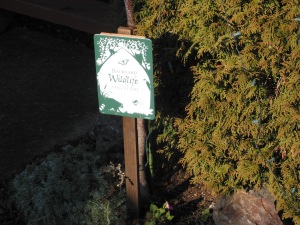
This garden is located in a part of Seattle called Greenwood. It’s an older part of town that once was its own separate community till it was incorporated under the Seattle charter last century. It used to be the terminus of a wonderful street car line that the foolish City Fathers decided to trash some time ago. It’s too bad because now they’re trying to bring in other streetcars in places and light rails and other things that the streetcar would have made unnecessary. Seems like the way it goes in a lot of cities and it’s too bad it happened here. This garden is almost on the edge of the northern boundary of the city now with just one neighborhood separating us from the neighboring community of Shoreline.
It’s a quiet part of town with lots of trees and parks and a middle/working class neighborhood feel and a rich diversity of people and ideas developing as time goes on. I won’t say it’s not mostly white bread still cause it is but there are a lot of ethnic minorities and gays and lesbians and other folks moving in in droves and it’s becoming quite the little hot spot. There are several grocery stores and all sorts of restaurants, a post office and a Library all within close walking distance to this home. It’s peaceful here right where the garden is tho being in the middle of a set of blocks bounded by busier streets but this is in a quiet area and doesn’t get much traffic or problems, tho there is the odd stick up or shooting or even a murder here too as there is all over Seattle. It’s a medium sized city and has all the problems of a place its size. And Greenwood isn’t immune to them.
But here in the heart of Greenwood is this precious little Wildlife Sanctuary on a small city lot. It’s an easy thing to do. You just register with the Dept. of Fish and Wildlife and send them $5 and a form they have you fill out with your plant list and a list of animals and birds that visit you and you get this nifty yard sign above and a placard to hang on your wall like I did. It’s very cool and I wish more people would take the time to do it and have more of these Sanctuaries around town. They’re unique little islands of calm and an oasis for the birds especially. Greenwood is a perfect place to have one too.
Be a Safe Haven for the Wildlife,
Steve
19
Nov
Posted by steven1111 in Dwarf Plants, Gardening, Gardens, Nature, Peat Bogs, Sanctuaries, Unusual Plants, Wet Soils. Tagged: Dwarf Plants, Gardening, Nature, Peat Bogs, Personal Gardens, Sanctuary, Unusual Plants, Wet Soils. Leave a comment
 As I look out at the garden today I see big puddles of the rain that’s been coming down for the past few days and shows no signs of quitting. In fact it’s supposed to get stronger. This place is in the Piper’s Creek watershed and there are many places the creek pokes up thru the gardens of the neighbors but for this garden it just shows up when it rains too much and the water fills in areas. I’ve had to redo the whole north side of the garden with special plants like the swamp cypress and a creek dogwood to allow there to be plants that can not only withstand the water but actually thrive it it. I did a lot of research before I replanted the ones that died before from the water build up. Plus there’s the neighbor’s overflow since they don’t have a gutter so it all comes down in this yard. Totally unfair, but what can ya do?
As I look out at the garden today I see big puddles of the rain that’s been coming down for the past few days and shows no signs of quitting. In fact it’s supposed to get stronger. This place is in the Piper’s Creek watershed and there are many places the creek pokes up thru the gardens of the neighbors but for this garden it just shows up when it rains too much and the water fills in areas. I’ve had to redo the whole north side of the garden with special plants like the swamp cypress and a creek dogwood to allow there to be plants that can not only withstand the water but actually thrive it it. I did a lot of research before I replanted the ones that died before from the water build up. Plus there’s the neighbor’s overflow since they don’t have a gutter so it all comes down in this yard. Totally unfair, but what can ya do?
A Joke around the house is that once a piece of tin foil blew off the Bar b Que and flew into the garden and fell onto the peaty soil and within a few weeks there was a ten foot flagpole growing there! Just kidding but that’s about true because I’ve been amazed at how fast some of the plants I’ve put in have grown. Realize that this whole garden, except for the upper story and background plantings, is only 3 years old and I started with some small plants for the most part for the cost and because I’ve found that usually a 1 or 2 gallon plant will catch up with a 5 gallon one in a few years. I’ve splurged on occasion for some special plants and gotten big ones but mostly they’ve been small and the peat provided such a rich medium for growth that they do well. I also believe strongly in mulching and I’ve used a fertile mulch from one of the local nurseries made from composted manure and sawdust that works so well it’s incredible. It absorbs the water and allows me to mound up areas with soil and mulch for a textured look to give some form and definition to the garden as a whole.
Once when a gate was being put in the hole that was dug hit water at 2 feet and tho this was in the spring it’s true it’s indicative of what it’s like here. A previous owner of the place once stuck a 20 foot piece of rebar into the ground by hand and drove it all the way in and never struck hardpan or bedrock. The neighbor had to put in equally deep footings to build their house and at one point a piece of earth moving equipment they were using tipped over and almost fell on this house and it took a couple of Big tow trucks to get it back safely on the ground. It’s funny tho because the neighbor across the street has clay and a totally different soil mix. So I guess the Peat flows in rivers or channels thru the neighborhood and it’s just lucky that the garden here is in one of those channels. I haven’t yet found any evidence of previous inhabitants in the peat like they do in the UK in places, but I wouldn’t be surprised I guess. Maybe someday I’ll unearth a treasure. Time will tell as we garden here in the Peat.
Peat and Love,
Steve
19
Nov
Posted by steven1111 in Dwarf Plants, Gardening, Gardens, Nature, Pruning, Unusual Plants. Tagged: Dwarf Plants, Gardening, Nature, Peat Bogs, Personal Gardens, Sanctuary, Unusual Plants, Wet Soils. Leave a comment
 There are a lot of aspects to maintaining a good garden. And one of them is pruning. Another is choosing the right size plant to fit where they belong. I have some opinions about this which I’ll talk about a bit here. I’m talking about the way I’ve done things in my landscaping businesses and nurseries I’ve worked in for over 20 years as well as my own gardens for longer than that. I don’t say this is the only way to do things but it’s what I’ve come to believe works best. It’s how I approach my own garden.
There are a lot of aspects to maintaining a good garden. And one of them is pruning. Another is choosing the right size plant to fit where they belong. I have some opinions about this which I’ll talk about a bit here. I’m talking about the way I’ve done things in my landscaping businesses and nurseries I’ve worked in for over 20 years as well as my own gardens for longer than that. I don’t say this is the only way to do things but it’s what I’ve come to believe works best. It’s how I approach my own garden.
I have to be creative in my pruning methods but that’s ok. I love to prune and learned from a man who taught me to do “aesthetic and therapeutic’ pruning so that the plant remains healthy but its artistic elements are also encouraged and so it would fit in place with its neighbors in harmony. I try to do that with all my garden work. I believe that plants, and people, do best when they are allowed to grow to be themselves. So in my garden design businesses I always tried to allow for the eventual size and shape of a plant to be allowed for in the design.
I have a theory that the reason many people don’t like some plants is simply that they were planted in the wrong spots and thus required too much work. If a plant had been put there that matured to the right size it might never have been a problem. Anyway I’ve tried my best to follow this in my own garden but I admit my collector’s eye has gotten me into some tight spaces here and there and I’ll have to be very careful as to how I grow this garden at times. That’s ok tho as it gives me something exciting to do and work to accomplish for many years as I live and grow with this garden.
And remember: Stop Topping Trees! ( slogan courtesy of Plant Amnesty, of which I am a member. It’s an organization that advocates for proper pruning and other fine things.) It may have its place in an orchard but rarely in a good garden. Be careful. Would You want Your head and limbs cut off willy nilly? Think about it. There’s almost always a better way.
Happy and Careful Pruning and Planting,
Steve
17
Nov
Posted by steven1111 in Dwarf Plants, Gardening, Gardens, Nature, Peat Bogs, Sanctuaries, Unusual Plants, Wet Soils. Tagged: Dwarf Plants, Gardening, Nature, Peat Bogs, Personal Gardens, Sanctuary, Unusual Plants, Wet Soils. 4 comments
 So far today it’s been raining here in Seattle. What a shock I know but it really doesn’t rain as much as people think ya know. It’s just overcast and cloudy a lot but now we really are in the rainy season and I can’t use that excuse. It’s truly raining and I love it. I hear people complaining about the rain all the time but if it didn’t rain so much here it wouldn’t be the lush green oasis that draws so many people here to live, and to die sometimes as well in the oppressive atmosphere of the heavy weather and dark skies. I know what that’s like myself suffering from depression as I do but why go there now? Plenty of time to discuss my moods later.
So far today it’s been raining here in Seattle. What a shock I know but it really doesn’t rain as much as people think ya know. It’s just overcast and cloudy a lot but now we really are in the rainy season and I can’t use that excuse. It’s truly raining and I love it. I hear people complaining about the rain all the time but if it didn’t rain so much here it wouldn’t be the lush green oasis that draws so many people here to live, and to die sometimes as well in the oppressive atmosphere of the heavy weather and dark skies. I know what that’s like myself suffering from depression as I do but why go there now? Plenty of time to discuss my moods later.
What I’m mostly about talking towards here is gardening and I’ll do a lot of that as time goes on. I’ve been avid for it for years as I say later on, and here I go repeating myself already, but It’s in my blood so just try to enjoy it. Of course it’s hard to garden in the rain, and mostly things are a bit quiescent in the garden right now as fall really comes over us. But the Taxodium distichum Peve Minaret still has leaves on it as does the Metasequoia Miss Grace and even the Red Pygmy Maple has some leaves left and they’re gorgeous in their fall colors of orange and red and finally a golden yellow.
I love the fall, maybe because I was born a few day ago (well 62 years and a few days ago really), and I think sometimes that the time when a person is born is a time they love, but I guess that’s not always true is it? But it is for me and fall has always thrilled me with the changing season. The Time of Falling off and Dying as my Native teacher called it. I guess my Scorpio blood and Phoenix nature (you’ll see my Gravatar is a two-headed Phoenix) is awakened by this activity of the dark side of renewal, but then all gardeners recognize this part of it. Things have to die away and leave their bodies on the soil for new life to begin again in the spring. It’s just the Way of it. And with that I’ll close for now and leave the rest to say another day.
Peace to you all.
Steve
 In this one you can see the Plum and why I need to prune the Parrotia away from it. They have to agree to share the air space above them. I think I did a good job of preparing them to play nice. The small blue conifer at the bottom is a RH Montgomery blue spruce. It wants to get bigger than it can here so I have to prune it very judiciously to keep it looking nice and healthy where it is. We’ll see how long I can do that. At the right is a mid-size Lily of the Valley shrub called Little Heath (Pieris japonica “Little Heath”). It has lovely racemes of small white bell shaped flowers in early spring. The leaves are nicely variegated with light green and pink on the margins, especially in spring. It’s another plant in the Heather family.
In this one you can see the Plum and why I need to prune the Parrotia away from it. They have to agree to share the air space above them. I think I did a good job of preparing them to play nice. The small blue conifer at the bottom is a RH Montgomery blue spruce. It wants to get bigger than it can here so I have to prune it very judiciously to keep it looking nice and healthy where it is. We’ll see how long I can do that. At the right is a mid-size Lily of the Valley shrub called Little Heath (Pieris japonica “Little Heath”). It has lovely racemes of small white bell shaped flowers in early spring. The leaves are nicely variegated with light green and pink on the margins, especially in spring. It’s another plant in the Heather family.






































































































































































































